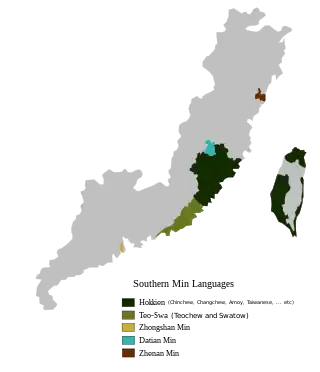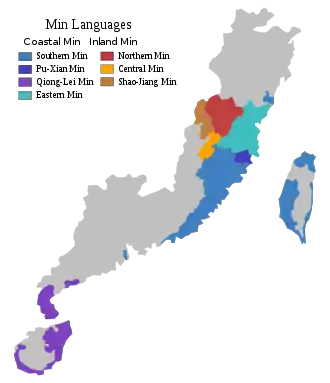| Hailufeng | |
|---|---|
| Hai Lok Hong | |
| Haklau | |
| Region | Mainly in Shanwei, eastern Guangdong province. |
Native speakers | 2.65 million (2021)[1] |
Early forms | |
| Language codes | |
| ISO 639-3 | (hlh is proposed[5]) |
| ISO 639-6 | hife |
| Glottolog | None |
| Linguasphere | 79-AAA-jik (Haifeng) |
 | |
| Haklau Min | |||||||||||||||||
|---|---|---|---|---|---|---|---|---|---|---|---|---|---|---|---|---|---|
| Traditional Chinese | 海陸豐話 | ||||||||||||||||
| Simplified Chinese | 海陆丰话 | ||||||||||||||||
| |||||||||||||||||
Hailufeng (海陸丰 Hai Lok Hong), or in the language itself Haklau, is a variety of Chinese mostly spoken in the Hailufeng region of Guangdong. The region includes Shanwei (Swabue), which administratively includes Haifeng County (海丰 Hai Hong), and Lufeng City (陸丰 Lok Hong), which itself was a former county and now county-level city. The name 'Hailufeng' / 'Hai Lok Hong' (海陸丰) is a portmanteau of those places. It is a Southern Min (Min Nan) language with similarities to Hokkien, especially Chiangchew Hokkien, though it also has close geographical and cultural ties with neighboring Teochew.[6][7] Ethnically, the Haklau see themselves as Hailok, separate from the Teochews.
Differences from Teochew include the preservation of the final codas -t and -n, which are completely lost in Teochew, as well as the absence of the -oi finals.
Notes
References
- ↑ "Reclassifying ISO 639-3 [nan]: An Empirical Approach to Mutual Intelligibility and Ethnolinguistic Distinctions" (PDF). Archived from the original (PDF) on 2021-09-19.
- ↑ Mei, Tsu-lin (1970), "Tones and prosody in Middle Chinese and the origin of the rising tone", Harvard Journal of Asiatic Studies, 30: 86–110, doi:10.2307/2718766, JSTOR 2718766
- ↑ Pulleyblank, Edwin G. (1984), Middle Chinese: A study in Historical Phonology, Vancouver: University of British Columbia Press, p. 3, ISBN 978-0-7748-0192-8
- ↑ Hammarström, Harald; Forkel, Robert; Haspelmath, Martin; Bank, Sebastian (2023-07-10). "Glottolog 4.8 - Min". Glottolog. Leipzig: Max Planck Institute for Evolutionary Anthropology. doi:10.5281/zenodo.7398962. Archived from the original on 2023-10-13. Retrieved 2023-10-13.
- ↑ "Change Request Documentation: 2021-045". 31 August 2021. Retrieved 30 May 2022.
- ↑ "Cháozhōuhuà pīnyīn fāng'àn / ChaoZhou Dialect Romanisation Scheme". sungwh.freeserve.co.uk (in Chinese and English). Archived from the original on 2008-07-20. Retrieved 2008-11-06.
- ↑ Campbell, James. "Haifeng Dialect Phonology". glossika.com. Archived from the original on 2007-08-14. Retrieved 2008-11-06.

